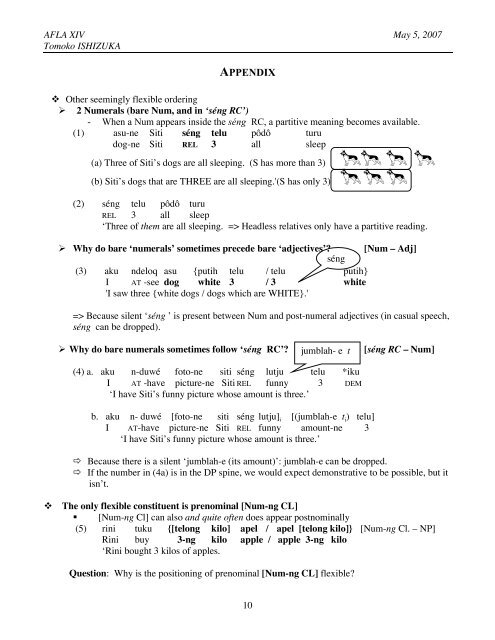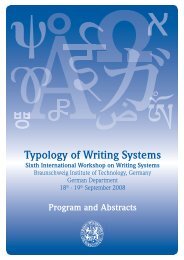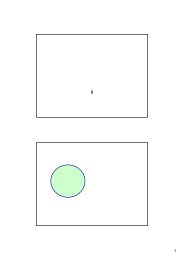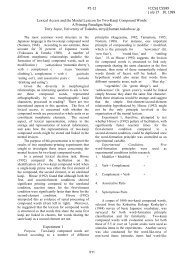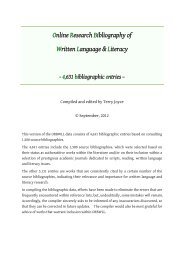Internal Structure of the DP in Javanese*
Internal Structure of the DP in Javanese*
Internal Structure of the DP in Javanese*
You also want an ePaper? Increase the reach of your titles
YUMPU automatically turns print PDFs into web optimized ePapers that Google loves.
AFLA XIV May 5, 2007Tomoko ISHIZUKAAPPENDIX O<strong>the</strong>r seem<strong>in</strong>gly flexible order<strong>in</strong>g 2 Numerals (bare Num, and <strong>in</strong> ‘séng RC’)- When a Num appears <strong>in</strong>side <strong>the</strong> séng RC, a partitive mean<strong>in</strong>g becomes available.(1) asu-ne Siti séng telu pôdô turudog-ne Siti REL 3 all sleep(a) Three <strong>of</strong> Siti’s dogs are all sleep<strong>in</strong>g. (S has more than 3)(b) Siti’s dogs that are THREE are all sleep<strong>in</strong>g.'(S has only 3)(2) séng telu pôdô turuREL 3 all sleep‘Three <strong>of</strong> <strong>the</strong>m are all sleep<strong>in</strong>g. => Headless relatives only have a partitive read<strong>in</strong>g. Why do bare ‘numerals’ sometimes precede bare ‘adjectives’? [Num – Adj]séng(3) aku ndeloq asu {putih telu / telu putih}I AT -see dog white 3 / 3 white'I saw three {white dogs / dogs which are WHITE}.'=> Because silent ‘séng ’ is present between Num and post-numeral adjectives (<strong>in</strong> casual speech,séng can be dropped). Why do bare numerals sometimes follow ‘séng RC’?jumblah- e t[séng RC – Num](4) a. aku n-duwé foto-ne siti séng lutju telu *ikuI AT -have picture-ne Siti REL funny 3 DEM‘I have Siti’s funny picture whose amount is three.’b. aku n- duwé [foto-ne siti séng lutju] i [(jumblah-e t i ) telu]I AT-have picture-ne Siti REL funny amount-ne 3‘I have Siti’s funny picture whose amount is three.’ Because <strong>the</strong>re is a silent ‘jumblah-e (its amount)’: jumblah-e can be dropped. If <strong>the</strong> number <strong>in</strong> (4a) is <strong>in</strong> <strong>the</strong> <strong>DP</strong> sp<strong>in</strong>e, we would expect demonstrative to be possible, but itisn’t. The only flexible constituent is prenom<strong>in</strong>al [Num-ng CL] [Num-ng Cl] can also and quite <strong>of</strong>ten does appear postnom<strong>in</strong>ally(5) r<strong>in</strong>i tuku {[telong kilo] apel / apel [telong kilo]} [Num-ng Cl. – NP]R<strong>in</strong>i buy 3-ng kilo apple / apple 3-ng kilo‘R<strong>in</strong>i bought 3 kilos <strong>of</strong> apples.Question: Why is <strong>the</strong> position<strong>in</strong>g <strong>of</strong> prenom<strong>in</strong>al [Num-ng CL] flexible?10


